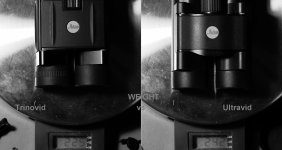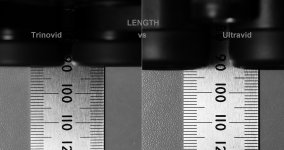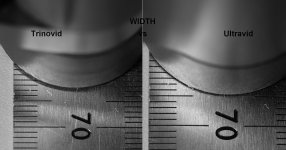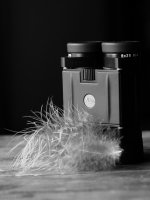dorubird
The unskilled mechanic blames his tools!

For a very long time I wanted to make this comparison, but I never had the opportunity to look through Ultravid next to Trinovid. My samples are new generations, benefiting from the latest coatings.
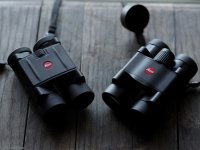
Design and exterior finishes
Trinovid, in my opinion, has a more mature and pleasant design due to its simplicity and functionality. And the Ultravid has a slightly more elaborate design with beautiful curved and soft lines. But Ultravid armor has some joints lines that give the impression of a rough state, while Trinovid has these armor joints lines well hidden under the hinge. (Trinovid win)
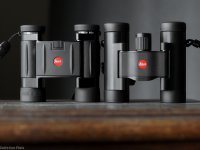
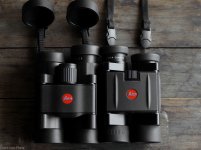
Mechanics
Mechanical parts of the two binoculars have fine and precise adjustments (stiff hinges, with precise focus, diopter and eyecup adjustments). (draw)
Focus system
Here we have two different approaches: Trinovid has a minimalist focus wheel, hidden in the volume of the binoculars, serving ideas of the smallest possible volume. It moves precisely without slipping, with a small but pleasant feeling of graininess. Instead, Ultravid has a large and obvious wheel serving ideas of convenience, with an equally precise movement but with a silkier feeling. (Ultravid win)
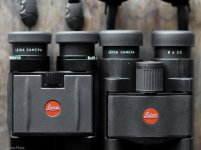
Interior finish is better blackened in Ultravid. Instead, Trinovid uses brighter materials and paints. This generating optical problems (see in the Optics category). (Ultravid win)
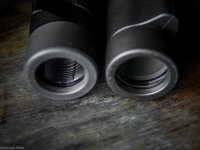
Diopter adjustment -+3.5 diopters. vs -+5 dioptr. Here Trinovid leaves a bigger margin for those with larger dioptre differences. (Trinovid win)
Ergonomics is better at Ultravid due to the larger focus wheel. However, the long habit makes Trinovid comfortable also - "habit is second nature" Blaise Pascal. (Ultravid win)
Waterproof. Trinovid only splash-proof vs Ultravid 0.5bar (Ultravid win)
Accessory. Ultravid has raincovers, very useful for protection when the binoculars are hanging around your neck. Trinovid has a strap with quick release (Ultravid win)
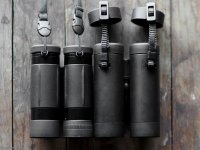
Weight with straps (Ultravid caps) 232g vs 256g. The 24 grams less are not felt in reality, but they are the result of a smaller body of Trinovid. (draw)
Dimensions at first glance are very similar! But if we put both binoculars next to each other the difference becomes visible. Trinovid is slightly smaller in all directions. The Ultravid no longer fits in the small bag bought for Trinovid!!! (Trinovid win)
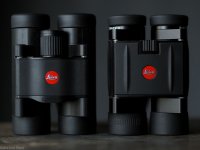
Optics
Both have roof prism with phasecorrecting coating P40 and HighLux-System HLS, and lenses with HDC multicoating (provides abrasion-resistance). Only Ultravid has AquaDura coating on outer lenses.
I noticed colors differences in the eyepieces , objectives and prisms coatings. Ultravid also has slightly larger eyepiece lenses diameter (16.5mm vs 15.5mm).
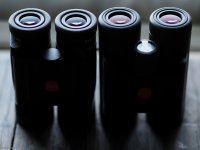
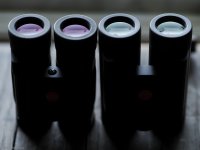
Contrast is the main advantage of Ultravid over Trinovid. It is obviously higher, Ultravid having a much more vivid image than Trinovid. (Ultravid win)
Resolution on the center. After the tests, despite the big difference in contrast, I came to the conclusion that these two binoculars resolve the same number of details. Perfect equality!! (draw)
Resolution on the edges. Here we can see a big difference. Ultravid 90% of the FOV is clear, while with Trinovid about 80% of the FOV is clear. (Ultravid win)
Glare resistance. Ultravid's very good glare resistance is what also contributes to the great contrast advantage during the day with strong sun. Compared, Trinovid has lot of glare! (Ultravid win)
White balance is very similar, the color palette being very similar with pleasant saturation of colors, specified by Leica! (draw)
Brightness. The visual estimation of the brightness is very subjective and dependent on the conditions and very difficult to appreciate, because other important variables are also involved in this appreciation: the colors and the contrast. The colors of these binoculars being extremely similar with an identical white balance, only the higher contrast of the Ultravid remained to influence my perception of brightness. Due to this strong contrast of the Ultravid, in strong light conditions, it gives me the illusion that it is a little darker than the Trinovid. But this is just an illusion, because the Trinovid has a weaker contrast and seems to have a slightly washed out image. This washing is illusory perceived by my brain as a false brightness. But in conditions of much lower brightness, I struggled a lot to see any difference and I could not distinguish it between the two binoculars! If I had seen some difference in dark conditions, it would seem to be in the advantage of the Ultravid, but honestly I think it is a tie! (draw)
Chromatic aberrations are minimal and only on the edges. For me, it does not present any kind of problem in both binoculars. But it seems a little better managed aberrations in Ultravid, especially on the edges (Ultravid win)
Geometric distortion is more pronounced on the edges at Trinovid. But Ultravid also has a bit of distortion. (Ultravid win)
Eye relief. From the specifications, both binoculars have the same 15mm. But it seems to me that Ultravidul has a very small advantage due to the slightly larger diameters of the eyepiece lenses. To see the entire FOV, I need to press a little less on the glasses than with Trinovid. (Ultravid win)
Field of View tested on stellar fields is identical in both binoculars (6.5 deg.), resulting same 52 deg AFOV. (draw)
Ultravid can focus at 1.75m (measured by me) and Trinovid only 2.40m (measured by me) . Competition exemple: Curio 7x21- 2.5m (from specification), Nikon HG L 8x20- 2.4m (from specification), Zeiss VP 8x25- 1.75m (measured by me) (Ultravid win)
Conclusions
These two binoculars optically share the same DNA (colors, FOV, center resolution). But the comparison shows two important differences in optical performance:
1 Overall contrast of the image is much higher in Ultravid (due to the more matte black paint and better coating) and
2 Resolution on the edges is visibly more extended at Ultravid (90% of FOV vs 80% of FOV)
These optic differences make the Ultravid image visible more spectacular than his brother!
But when it comes to dimensions, the Trinovid takes the top prize here (small but visible differences). Also, Trinovid design is more beautiful from my point of view (subjective).
Personally, I'm interested that such binoculars to have double hinge to fold as small as possible, so they can be easily carried in a backpack, belt case or pocket. Pocket binoculars are anyway for promenade or unexpected situations, also having value as an object design.
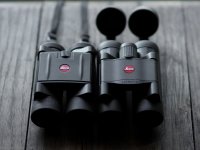

Design and exterior finishes
Trinovid, in my opinion, has a more mature and pleasant design due to its simplicity and functionality. And the Ultravid has a slightly more elaborate design with beautiful curved and soft lines. But Ultravid armor has some joints lines that give the impression of a rough state, while Trinovid has these armor joints lines well hidden under the hinge. (Trinovid win)


Mechanics
Mechanical parts of the two binoculars have fine and precise adjustments (stiff hinges, with precise focus, diopter and eyecup adjustments). (draw)
Focus system
Here we have two different approaches: Trinovid has a minimalist focus wheel, hidden in the volume of the binoculars, serving ideas of the smallest possible volume. It moves precisely without slipping, with a small but pleasant feeling of graininess. Instead, Ultravid has a large and obvious wheel serving ideas of convenience, with an equally precise movement but with a silkier feeling. (Ultravid win)

Interior finish is better blackened in Ultravid. Instead, Trinovid uses brighter materials and paints. This generating optical problems (see in the Optics category). (Ultravid win)

Diopter adjustment -+3.5 diopters. vs -+5 dioptr. Here Trinovid leaves a bigger margin for those with larger dioptre differences. (Trinovid win)
Ergonomics is better at Ultravid due to the larger focus wheel. However, the long habit makes Trinovid comfortable also - "habit is second nature" Blaise Pascal. (Ultravid win)
Waterproof. Trinovid only splash-proof vs Ultravid 0.5bar (Ultravid win)
Accessory. Ultravid has raincovers, very useful for protection when the binoculars are hanging around your neck. Trinovid has a strap with quick release (Ultravid win)

Weight with straps (Ultravid caps) 232g vs 256g. The 24 grams less are not felt in reality, but they are the result of a smaller body of Trinovid. (draw)
Dimensions at first glance are very similar! But if we put both binoculars next to each other the difference becomes visible. Trinovid is slightly smaller in all directions. The Ultravid no longer fits in the small bag bought for Trinovid!!! (Trinovid win)

Optics
Both have roof prism with phasecorrecting coating P40 and HighLux-System HLS, and lenses with HDC multicoating (provides abrasion-resistance). Only Ultravid has AquaDura coating on outer lenses.
I noticed colors differences in the eyepieces , objectives and prisms coatings. Ultravid also has slightly larger eyepiece lenses diameter (16.5mm vs 15.5mm).


Contrast is the main advantage of Ultravid over Trinovid. It is obviously higher, Ultravid having a much more vivid image than Trinovid. (Ultravid win)
Resolution on the center. After the tests, despite the big difference in contrast, I came to the conclusion that these two binoculars resolve the same number of details. Perfect equality!! (draw)
Resolution on the edges. Here we can see a big difference. Ultravid 90% of the FOV is clear, while with Trinovid about 80% of the FOV is clear. (Ultravid win)
Glare resistance. Ultravid's very good glare resistance is what also contributes to the great contrast advantage during the day with strong sun. Compared, Trinovid has lot of glare! (Ultravid win)
White balance is very similar, the color palette being very similar with pleasant saturation of colors, specified by Leica! (draw)
Brightness. The visual estimation of the brightness is very subjective and dependent on the conditions and very difficult to appreciate, because other important variables are also involved in this appreciation: the colors and the contrast. The colors of these binoculars being extremely similar with an identical white balance, only the higher contrast of the Ultravid remained to influence my perception of brightness. Due to this strong contrast of the Ultravid, in strong light conditions, it gives me the illusion that it is a little darker than the Trinovid. But this is just an illusion, because the Trinovid has a weaker contrast and seems to have a slightly washed out image. This washing is illusory perceived by my brain as a false brightness. But in conditions of much lower brightness, I struggled a lot to see any difference and I could not distinguish it between the two binoculars! If I had seen some difference in dark conditions, it would seem to be in the advantage of the Ultravid, but honestly I think it is a tie! (draw)
Chromatic aberrations are minimal and only on the edges. For me, it does not present any kind of problem in both binoculars. But it seems a little better managed aberrations in Ultravid, especially on the edges (Ultravid win)
Geometric distortion is more pronounced on the edges at Trinovid. But Ultravid also has a bit of distortion. (Ultravid win)
Eye relief. From the specifications, both binoculars have the same 15mm. But it seems to me that Ultravidul has a very small advantage due to the slightly larger diameters of the eyepiece lenses. To see the entire FOV, I need to press a little less on the glasses than with Trinovid. (Ultravid win)
Field of View tested on stellar fields is identical in both binoculars (6.5 deg.), resulting same 52 deg AFOV. (draw)
Ultravid can focus at 1.75m (measured by me) and Trinovid only 2.40m (measured by me) . Competition exemple: Curio 7x21- 2.5m (from specification), Nikon HG L 8x20- 2.4m (from specification), Zeiss VP 8x25- 1.75m (measured by me) (Ultravid win)
Conclusions
These two binoculars optically share the same DNA (colors, FOV, center resolution). But the comparison shows two important differences in optical performance:
1 Overall contrast of the image is much higher in Ultravid (due to the more matte black paint and better coating) and
2 Resolution on the edges is visibly more extended at Ultravid (90% of FOV vs 80% of FOV)
These optic differences make the Ultravid image visible more spectacular than his brother!
But when it comes to dimensions, the Trinovid takes the top prize here (small but visible differences). Also, Trinovid design is more beautiful from my point of view (subjective).
Personally, I'm interested that such binoculars to have double hinge to fold as small as possible, so they can be easily carried in a backpack, belt case or pocket. Pocket binoculars are anyway for promenade or unexpected situations, also having value as an object design.

Last edited:








